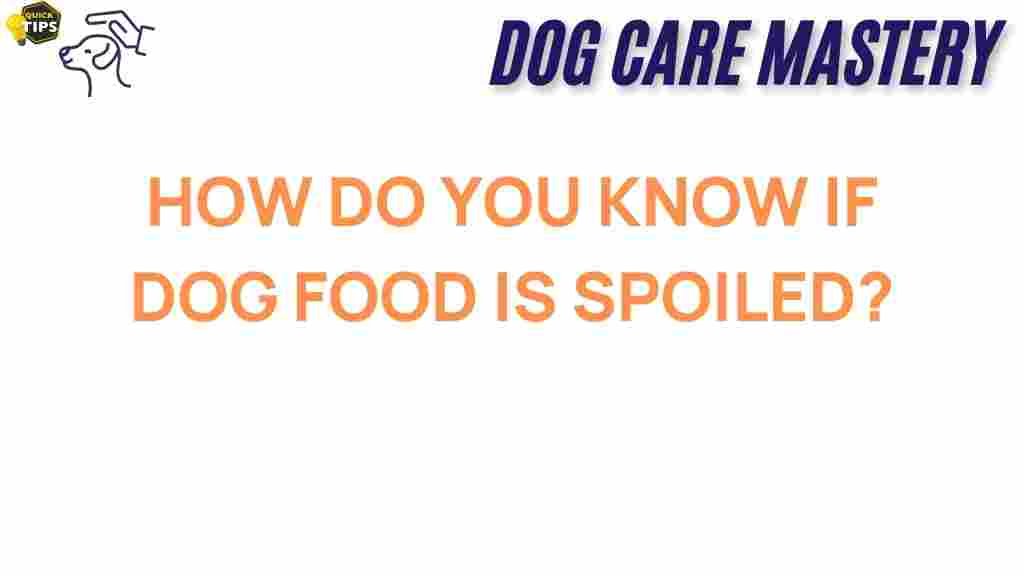Understanding Dog Food Safety: Signs Your Dog’s Food is Spoiled
As a responsible pet owner, ensuring your dog’s health and well-being is of utmost importance. One crucial aspect of this responsibility is understanding dog food safety. Spoiled dog food can lead to a variety of health issues, ranging from mild gastrointestinal upset to serious illness. This article will guide you through the signs of spoiled dog food, how to store it properly, and what to do if you suspect your dog’s food is no longer safe to eat.
Why Dog Food Safety Matters
Dog food is designed to provide complete nutrition for our furry friends, but like all perishable items, it can spoil over time. Spoiled dog food can be a breeding ground for harmful bacteria, leading to food poisoning in dogs. Understanding dog food safety can help you keep your dog healthy and happy.
Signs of Spoiled Dog Food
Identifying spoiled dog food is essential for preventing health issues. Here are the key signs to look out for:
- Unpleasant Odor: Fresh dog food has a mild, appetizing smell. If you detect a rancid or sour odor, it’s likely spoiled.
- Color Changes: Look for any discoloration in the kibble or canned food. Brown, grey, or faded colors can indicate spoilage.
- Mold or Fungi: Visible mold on the food is a clear sign that it should be discarded immediately.
- Texture Changes: If the kibble feels unusually soft or moist, it may have absorbed moisture and begun to spoil.
- Expiration Date: Always check the expiration date on the packaging. Consuming food past this date can pose health risks.
Step-by-Step Process to Ensure Dog Food Safety
Maintaining dog food safety requires careful attention to storage and handling. Follow these steps to ensure your dog’s food remains fresh:
1. Choose High-Quality Food
Select dog food from reputable brands that follow strict safety standards. Research the ingredients and manufacturing processes to ensure quality.
2. Check Packaging
Inspect the packaging for any signs of damage, such as tears or holes, which can compromise the food’s safety.
3. Proper Storage
Store dry kibble in an airtight container in a cool, dry place. For canned food, ensure the can is sealed and store it in a cool environment.
4. Maintain a Clean Feeding Area
Regularly clean your dog’s food and water bowls to prevent the growth of bacteria.
5. Monitor Food Temperature
Always serve dog food at room temperature. If you heat canned food, make sure it is not too hot, as this can alter its properties and potentially spoil it.
Troubleshooting Tips for Dog Food Safety
If you suspect that your dog’s food might be spoiled, here are some troubleshooting tips:
- Smell Test: If unsure, perform a smell test. If it smells off, it’s best to discard it.
- Visual Inspection: Look for any visible signs of spoilage, including mold, discoloration, or an unusual texture.
- Consult Your Vet: If your dog shows any signs of distress after eating, like vomiting or diarrhea, consult your veterinarian.
What to Do if You Discover Spoiled Dog Food
Finding spoiled dog food can be concerning, but knowing how to handle the situation is crucial:
- Dispose of the Food: Safely dispose of the spoiled food in a sealed bag to prevent other animals from accessing it.
- Clean the Storage Area: Sanitize any containers or areas where the food was stored to prevent contamination.
- Monitor Your Dog: Keep an eye on your dog for any signs of illness after consuming the spoiled food.
Educating Yourself on Dog Food Safety
For more comprehensive information on dog food safety, consider visiting the American Kennel Club’s website for guidelines and tips. Additionally, staying informed about the latest pet food recalls and safety alerts can also help ensure your dog’s food remains safe.
Conclusion
Understanding dog food safety is essential for every pet owner. By recognizing the signs of spoiled dog food and following proper storage and handling procedures, you can help keep your furry friend healthy and safe. Always prioritize quality and freshness when it comes to your dog’s diet, and don’t hesitate to consult your veterinarian for personalized advice. Protecting your pet starts with informed decisions about their food!
For further reading on pet care and nutrition, check out our comprehensive guide on dog health.
This article is in the category Health and created by dogcaremastery Team
